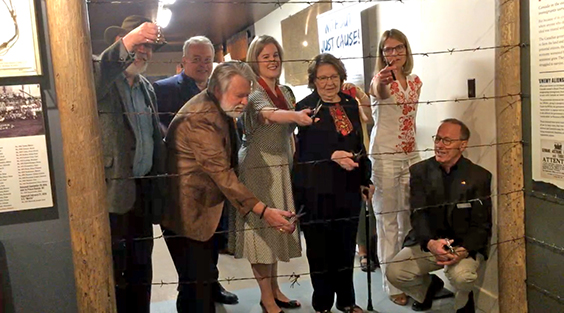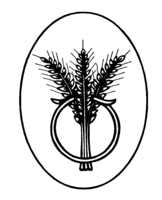Remarks of Dr. Bohdan Kordan, Professor Emeritus, Prairie Centre for the Study of Ukrainian Heritage, St. Thomas More College, University of Saskatchewan at the official opening of the permanent Eaton Internment display, Saskatchewan Railway Museum, 4 June 2022, 10:00 am.
FOR RELEASE ON DELIVERY
_________________________________________________________________________________
On a February day some 103 years ago, something unusual happened on this very site – Eaton as it was then known. A train pulled up to the siding and off-loaded its human cargo. It was a small group – sixty-five men in total – who had been relocated from Munson, Alberta, a railway junction down the line where, earlier, they had escaped the harrowing experience of the 1918 Spanish Influenza and a train wreck that nearly claimed their lives. Having arrived at this new destination and under the watchful eye of a small detachment of Canadian soldiers, they surveyed their new surroundings. Looking out at the open prairie, they would have despaired. The endless horizon was a metaphor for their sense of loss and abandonment. Confined in railway cars and put to work under armed guard repairing track, they were mystified as to why they were being subjected to such cruel treatment. What had they done to deserve this?
Invited by the promise of opportunity, they had immigrated earlier to Canada. For most Canadians, these new arrivals were unfamiliar, strangers yet neighbours, they spoke a language and engaged in customs and habits not easily understood but whose labour was needed. Originating from lands now at war with Britain and the Empire, they would be designated aliens of enemy origin as fear and suspicion surfaced with war’s onset. The allegiances of such people, it was felt, lay with their ancestral lands, not Canada. As a result, under emergency legislation – the War Measures Act – the government of Canada issued orders enabling it to monitor and, if needed, intern as prisoners of war those identified as enemy aliens.
The emergency powers granted the government under the Act also enabled it to deal with growing unemployment among the enemy alien population, the result of a contracting economy and a hostile public that saw foreigners as competitors and rivals. The government would resort to internment to address the problem. With nowhere to go and no prospect of employment, some 8,579 enemy aliens, mostly of Ukrainian origin, were interned as war prisoners. Of those detained, the majority were destitute and unemployed. They were apprehended across Canada in various cities — Winnipeg, Toronto, Montreal, Calgary, Victoria, and Saskatoon – as well as towns – Lethbridge, Brandon, Nanaimo, and Moose Jaw – and villages and hamlets, including Lamont, Ladysmith, Fernie, Melville, Willkie, and Dauphin. An additional 80,000 were required to register, always carry identification papers, and report weekly to local magistrates or other officials, all of whom would pass judgment over their lives and freedom.
The arrests prompted the government to establish internment camps, primarily located in the Canadian hinterland of the Rocky Mountains, the northlands of Ontario and Quebec, and the BC interior. In total, twenty-four facilities were created. As prisoners of war, the internees would be subject to military discipline, and at the point of a bayonet, forced to work clearing land and constructing roads under arduous and difficult conditions. In Banff, Jasper, Reveltsoke, and Yoho National Parks and at Morrrisey, Kapuskasing and Spirit Lake, they cleared bush and built roads. At Valcartier and Petawawa they expanded the military training grounds and artillery ranges. Near Truro, Dartmouth and Moncton, and later Munson, Alberta and Eaton, Saskatchewan, they repaired and laid new track. Throughout the ordeal, disobedience and defiance were met with corporal and other forms of punishment. Scores looked to escape. A few were shot in the attempt. Others fell into a deep melancholia and, succumbing to mental anguish, took their own lives. Most, however, chose to remain silent. Believing this was all a mistake, they waited in anxious disbelief for the war to end.
The experience of WWI internment represents a grim yet largely unknown episode in Canada’s history of participation in the Great War. It would involve the unjust treatment of immigrants who called Canada their home. As we reflect on this historical wrong, we are reminded about the importance of rights and freedoms, especially when the din of war overwhelms reason, and the hearts of men are hardened. To them – to the tens of thousands who were forced to register and report because they were designated enemies of Canada and to the thousands interned as war prisoners for no other reason than because of who they were and where they came from – we have a duty to remember.
As we open this permanent exhibit at the Saskatchewan Railway Museum, we reflect on the trials of those who were brought here. We also remember the many thousands interned elsewhere, who would return to their families and homes, picking up the pieces of their broken lives, pondering over the experience and the failed promise of Canada. We remember their pain, suffering, and misery. The goal, however, is not to engage in recrimination or blame, nor stoke the fires of resentment. Rather through this exhibit we invoke the memory of these past events as an act of reconciliation, declaring openly that a wrong was committed and an injustice had taken place here. Today, we launch this permanent exhibit as an act of political faith, stating unequivocally that history shall not be repeated and to alert future generations of the responsibility and obligation that we owe each other – to be tolerant, understanding, and caring.
But we also open this museum display today as the culmination of a partnership between various communities – Ukrainian and German – as well as organizations – the Saskatchewan Railway Museum and the Prairie Centre for the Study of Ukrainian Heritage at St. Thomas More College – who have come together to create this legacy, so that future generations may remember the importance of preserving rights and liberties. Most importantly, however, through your attendance here and participation in this ceremony you demonstrate your commitment to this enterprise. In doing so, you are reaching into the future, standing in solidarity with your children and your children’s children; knowing that when they come here to learn and reflect, they will grow to be more aware citizens, making Canada truly ‘strong and free.’

(L to R: Cal Sexsmith (Saskatchewan Railway Museum, President); Adrian Boyko (Shevchenko Foundation board member); Dr. Bohdan Kordan (Emeritus Professor and PCUH Affiliate); Dr. Nadya Foty-Oneschuk (PCUH, Interim Director), Patricia Mialkowsky (daughter of Internment survivor); Elena Krueger (UCC-SPC, President); Mervin Weiss (Saskatchewan German Council, President).
